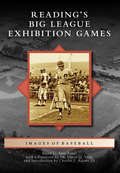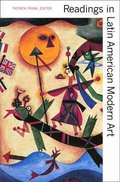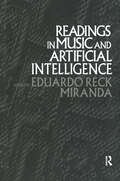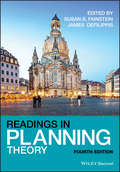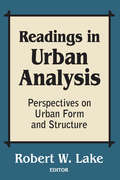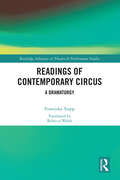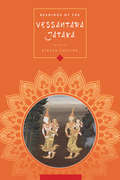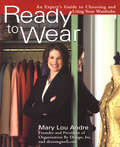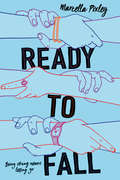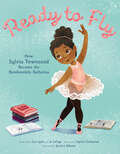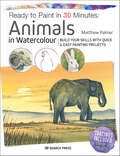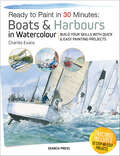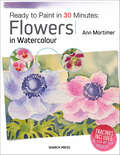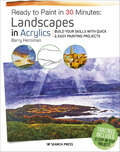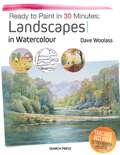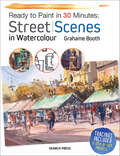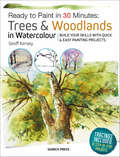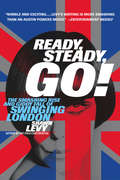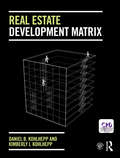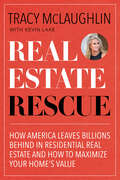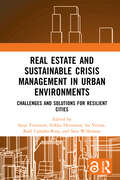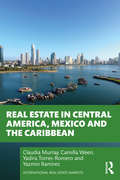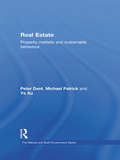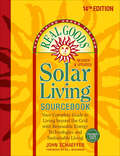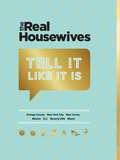- Table View
- List View
Reading's Big League Exhibition Games (Images of Baseball)
by Charles J. Adams III Brian C. Engelhardt Dr David VoigtWhile Reading may be known today for the Fightin' Phils, it has also been the site of 72 games played by 17 major-league franchises and barnstorming teams since 1874. Among the teams that have played in these exhibition games are the Philadelphia Phillies, Philadelphia Athletics, Pittsburgh Pirates, New York Giants, and St. Louis Cardinals, along with appearances by baseball greats Babe Ruth, Lou Gehrig, Mike Schmidt, Ernie Banks, and Rogers Hornsby. Reading fans have looked on as both the 1906 Phillies and A's tried to catch a bunny on the field mid-game, cheered for Christy Mathewson's shutouts, sang "Happy Birthday" to Pete Rose, and watched "Shoeless" Joe Jackson hit a home run.
Readings in Latin American Modern Art
by Patrick FrankThis volume is the first English-language anthology of writings on Latin American modern art of the twentieth century. The book includes some fifty seminal essays and documents--including statements, interviews, and manifestoes by artists--that encompass the broad diversity of this emerging field. Many of these materials are difficult to access and some are translated here for the first time. Together the selections explore the breadth and depth of Latin American modern art as well as its distinctive evolution apart from American and European art history. Included in this collection are fascinating ideas and insights on the impact of the avant-garde in the 1920s, the Mexican mural movement, Surrealism and other fantasy-based styles, modern architecture, geometric and optical art, concrete and neo-concrete art, and political conceptualism. For students and scholars of Latin American art, the volume offers an invaluable collection of primary and secondary sources.
Readings in Music and Artificial Intelligence (Contemporary Music Studies #20)
by Eduardo Reck MirandaFirst published in 2000. Routledge is an imprint of Taylor & Francis, an informa company.
Readings in Planning Theory
by Susan S. Fainstein James DeFilippisFeaturing updates and revisions to reflect rapid changes in an increasingly globalized world, Readings in Planning Theory remains the definitive resource for the latest theoretical and practical debates within the field of planning theory. Represents the newest edition of the leading text in planning theory that brings together the essential classic and cutting-edge readings Features 20 completely new readings (out of 28 total) for the fourth edition Introduces and defines key debates in planning theory with editorial materials and readings selected both for their accessibility and importance Systematically captures the breadth and diversity of planning theory and puts issues into wider social and political contexts without assuming prior knowledge of the field
Readings in Urban Analysis: Perspectives on Urban Form and Structure
by Robert W. LakeThis important work brings together a range of perspectives in contemporary urban analysis. The field of urban analysis is characterized by the multiplicity of approaches, philosophies, and methodologies employed in the examination of urban structure and urban problems. This fragmentation of perspectives is not simply a reflection of the multifaceted and complex nature of the city as subject matter. Nor is it a function of the variety of disciplines such as geography, planning, economics, history, and sociology. Cross-cutting all of these issues and allegiances has been the emergence in recent years of a debate on fundamental issues of philosophy, ideology, and basic assumptions underlying the analysis of urban form and structure. The notion of urban analysis Robert W. Lake discusses focuses on the spatial structure of the city, its causes, and its consequences. At issue is the city as a spatial fact: a built environment with explicit characteristics and spatial dimensions, a spatial distribution of population and land uses, a nexus of locational decisions, an interconnected system of locational advantages and disadvantages, amenities and dis-amenities. Beginning with landmark articles in neo-classical and ecological theory, the reader covers the latest departures and developments. Separate sections cover political approaches to locational conflict, institutional influences on urban form, and recent Marxist approaches to urban analysis. Among the topics included are community strategies in locational conflict, the political economy of place, the role of government and the courts, institutional influences in the housing market, and the relationship between urban form and capitalist development. This is a valuable introductory text for courses in urban planning, urban geography, and urban sociology.
Readings of Contemporary Circus: A Dramaturgy (ISSN)
by Franziska TrappWhat are the characteristics of contemporary circus? In what way does contemporary circus differ from theater, dance, and performance? Where do hybrid forms exist? Where are there observable commonalities? Despite the diversity of contemporary circus performances, are there generalizable characteristics that unite the performances? What potential do these questions have for dramaturgical practice?This book adapts a cultural-semiotic approach to analyze contemporary circus performances. It offers the first comprehensive documentation and interpretation of the art form based on the reading theories of cultural, literature, theater, and dance studies. The volume thereby provides a dramaturgy of contemporary circus, which reveals its generalizable characteristics, fundamental techniques and structures, and the effects they produce. At the same time, theories and methods are modified and further developed regarding the characteristics of the circus.This book is designed for students and scholars in the field of theater and performance studies, as well as for artists, dramaturges, and directors working in the field of circus.
Readings of the Vessantara Jātaka (Columbia Readings of Buddhist Literature)
by Steven CollinsThe Vessantara Jataka tells the story of Prince Vessantara, who attained the Perfection of Generosity by giving away his fortune, his children, and his wife. Vessantara was the penultimate rebirth as a human of the future Gotama Buddha, and his extreme charity has been represented and reinterpreted in texts, sermons, rituals, and art throughout South and Southeast Asia and beyond. This anthology features well-respected anthropologists, textual scholars in religious and Buddhist studies, and art historians, who engage in sophisticated readings of the text and its ethics of giving, understanding of attachment and nonattachment, depiction of the trickster, and unique performative qualities. They reveal the story to be as brilliantly layered as a Homeric epic or Shakespearean play, with aspects of tragedy, comedy, melodrama, and utopian fantasy intertwined to problematize and scrutinize Theravada Buddhism's cherished virtues.
Ready To Wear: An Expert's Guide to Choosing and Using Your Wardrobe
by Mary Lou AndreMost women feel like they can barely find their shoes in the morning-let alone pull together a stylish, snappy ensemble for the day. Mary Lou Andre is here to help. <P><P>An expert in wardrobe management and fashion consulting, she shows her clients how to find their own style-and make the most of what's already in their closets. And in this illustrated guide, she explains her effective wardrobe organization system and simple style strategies to help every woman get out the door faster-looking better than ever.
Ready to Fall: A Novel
by Marcella PixleyA young adult novel about a teen who finds hope and a fresh start after a terrible loss, and learns that being strong means letting go.When Max Friedman’s mother dies of cancer, instead of facing his loss, Max imagines that her tumor has taken up residence in his brain. It's a terrible tenant—isolating him from family, distracting him in school, and taunting him mercilessly about his manhood. With the tumor in charge, Max implodes, slipping farther and farther away from reality. Finally, Max is sent to the artsy, off-beat Baldwin School to regain his footing. He joins a group of theater misfits in a steam-punk production of Hamlet where he becomes friends with Fish, a girl with pink hair and a troubled past, and The Monk, an edgy upperclassman who refuses to let go of the things he loves. For a while, Max almost feels happy. But his tumor is always lurking in the wings—until one night it knocks him down and Max is forced to face the truth, not just about the tumor, but about how hard it is to let go of the past. At turns lyrical, haunting, and triumphant, Ready to Fall is a story of grief, love, rebellion and starting fresh from acclaimed author Marcella Pixley.
Ready to Fly: How Sylvia Townsend Became the Bookmobile Ballerina
by Lea Lyon Alexandria LaFayeLyrical, inspiring, and affecting text paired with bright, appealing illustrations make Ready to Fly perfect for aspiring ballerinas everywhere who are ready to leap and to spread their wings!Ready to Fly is the true story of Sylvia Townsend, an African American girl who falls in love with ballet after seeing Swan Lake on TV. This nonfiction picture book is an excellent choice to share at home or in the classroom. Although there aren’t many ballet schools that will accept a girl like Sylvia in the 1950s, her local bookmobile provides another possibility. A librarian helps Sylvia find a book about ballet and the determined seven-year-old, with the help of her new books, starts teaching herself the basics of classical ballet.Soon Sylvia learns how to fly—how to dance—and how to dare to dream.Includes a foreword from Sylvia Townsend, a brief history of the bookmobile, an author’s note, and a further reading list.
Ready to Paint in 30 Minutes: Animals in Watercolour
by Matthew PalmerThis complete beginner's guide to painting animals and birds is ideal if you want to learn to paint in watercolour but are short on time. Broken down into 32 quick and easy paintings measuring just 15 x 10cm (6 x 4in), this basic course will teach you all the skills you need to paint domestic and wild animals and birds, in home settings or in nature.Best-selling author Matthew Palmer shows you how to paint a diverse range of animals and birds, including a parrot, cat, dog, zebra, stag, cow and swan, and teaches you how to paint realistic markings, fur and feathers, and how to create faces filled with character and personality.Tracings are provided for all the paintings, including the three projects at the end of the book. Simply trace them off onto your watercolour paper and paint with confidence, without the need to make an initial drawing.Each painting takes just 30 minutes to complete and teaches you a different technique, so by the end of the book you will be equipped with all the skills you need to complete one of the three full-size projects: a King Charles cavalier spaniel, a snow leopard and a hummingbird.
Ready to Paint in 30 Minutes: Build Your Skills with Quick & Easy Painting Projects
by Charles Evans"This is a genuinely exciting evolution of a popular series. You’ll be guided through some simple exercises and on to complete paintings, gaining valuable insights that will develop and improve your skills." – Artbookreview.netThis guide to painting boats and harbours in watercolour is ideal if you want to learn to paint but are short on time. Broken down into 33 quick and easy postcard size paintings, this basic course will teach you all the skills you need to paint boats, yachts or barges on calm seas or raging waves, including how to depict reflections in water, realistic spray and the suggestion of a busy harbourside or coastal village.
Ready to Paint in 30 Minutes: Flowers in Watercolour
by Ann MortimerThis complete beginner’s guide to painting flowers in watercolour is ideal if you want to learn to paint but are short on time. Each of the 35 quick and easy exercises takes no more than 30 minutes to complete, and will teach you how to paint flowers of different shapes, colours and families – lilies, orchids and hellebores amongst others – or learn a key technique such as masking out, working wet in wet and colour-mixing. The exercises are all worked at postcard size – ideal for a 6 x 4in (A6) watercolour pad, and tracings are included for each study. The book is broken down into five chapters that focus, respectively, on working with watercolour, watercolour techniques, colour and tone, form and detail, and finally flowers in context. The final section of the book contains three complete paintings that demonstrate how to combine all the techniques and elements of painting flowers, as learned from the preceding chapters. These paintings, too, are accompanied by actual-size tracings.
Ready to Paint in 30 Minutes: Landscapes in Acrylics
by Barry HernimanThis beginner’s guide to painting the landscape in acrylics is ideal if you want to learn to paint but are short on time. Each of the 33 quick-and-easy studies takes no more than 30 minutes, and will teach you how to apply a crucial technique to your work, or paint a particular aspect of the natural landscape. The book also contains 3 larger paintings that demonstrate how to combine the elements learned into vibrant and inspiring landscapesBuild up your skills in easy chunks, learning about form and composition, colour mixing, working with acrylics and capturing the drama of the natural world.The exercises are all worked at postcard size – ideal for a 6 x 4 inch (A6) watercolour pad. All the required tracings are included.
Ready to Paint in 30 Minutes: Landscapes in Watercolour
by Dave WoolassThis guide to painting watercolour landscapes is ideal if you want to learn to paint but are short on time. Broken down into 33 quick and easy paintings that take no more than 30 minutes to complete, this basic course will teach you all the skills you need to paint landscapes and their components, including trees in winter, sparkling water, hedgerows and gates, animals, human figures and buildings in the landscape.The 30-minute paintings are all worked at postcard size – ideal for a 6 x 4in (A6) watercolour pad, and tracings are included for those with limited drawing skills. Each small painting is a work of art in its own right, and can be stored in your portfolio for reference later, or framed and hung on the wall to impress your friends.The book is broken down into chapters that focus, respectively, on essential watercolour techniques including colour mixing and glazing; laying washes and creating skies and realistic-looking clouds; the rudiments of composition; trees and flowers in a landscape; water– still and moving, from stream to open sea; and the living landscape – human and animal figures, structures and buildings in the landscape.The final section of the book contains three complete paintings that demonstrate how to combine all the techniques and elements of painting landscapes, as gleaned from the preceding chapters. These paintings, too, are accompanied by actual-size tracings.There are 33 tracings in all to help you compose your own landscape paintings.Praise for the Ready to Paint in 30 Minutes series: “This is a genuinely exciting evolution of a popular series. You’ll be guided through some simple exercises and on to complete paintings, gaining valuable insights that will develop and improve your skills.” – Henry Malt, Artbookreview.net
Ready to Paint in 30 Minutes: Street Scenes in Watercolour
by Grahame BoothThis complete beginner’s guide to painting watercolour street scenes is ideal if you want to learn to paint but are short on time. Each of the 32 quick and easy exercises takes no more than 30 minutes and will teach you how to create a new street scene element – such as doorways, buildings and people – or work an exciting technique – such as creating washes, mixing colours and playing with perspective. The exercises are all worked at postcard size – ideal for a 6 x 4in (A6) watercolour pad, and actual-size tracings are included. The book is broken down into eight chapters: tone, colour, perspective, the wash, edge control, brush strokes, adding detail and, finally, putting it all together – this last section contains 3 finished paintings that demonstrate how to integrate a combination of the elements into vibrant and inspiring street scenes; these complete paintings also have an accompanying actual-size tracing.
Ready to Paint in 30 Minutes: Trees & Woodlands in Watercolour
by Geoff KerseyThis complete beginner’s guide to painting trees and woodlands is ideal if you want to learn to paint but are short on time. 30 quick and easy exercises, that each take no more than 30 minutes, offer you a complete course teaching all the skills you need to paint trees on their own and as part of beautiful woodland scenes.The 30-minute paintings are all worked at postcard size – ideal for a 6" x 4" (A6) watercolour pad, and outline drawings are provided on tracing paper for those who are less confident at drawing. Each of the small paintings focuses on a specific subject or technique and is a work of art in its own right. Store them in your portfolio as an easy reference for future painting projects, or even frame them and display them on the wall to impress your family and friends.The final section of the book contains three complete paintings that demonstrate how to combine everything you've learned in the previous exercises. These paintings are also accompanied by actual-size tracings.
Ready, Steady, Go!: The Smashing Rise and Giddy Fall of Swinging London
by Shawn LevyIt’s the summer of 1966... The fundamental old ways: chastity, rationality, harmony, sobriety, even democracy: blasted to nothing or crumbling under siege. The city glows. It echoes. It pulses. It bleeds pastel and fuzzy, spicy, paisley and soft. This is how it's always going to be: smashing clothes, brilliant music, easy sex, eternal youth, the eyes of everybody, everyone's first thought, the top of the world, right here, right now: Swinging London.Shawn Levy has a genius for unearthing the secret history of popular culture. The Los Angeles Times called King of Comedy, his biography of Jerry Lewis, "a model of what a celebrity bio ought to be–smart, knowing, insightful, often funny, full of fascinating insiders' stories," and the Boston Globe declared that Rat Pack Confidential "evokes the time in question with the power of a novel, as well as James Ellroy's American Tabloid and better by far than Don DeLillo's Underworld."In Ready, Steady, Go! Levy captures the spirit of the sixties in all its exuberance. A portrait of London from roughly 1961 to 1969, it chronicles the explosion of creativity–in art, music and fashion–and the revolutions–sexual, social and political–that reshaped the world. Levy deftly blends the enthusiasm of a fan, the discerning eye of a social critic and a historian's objectivity as he re-creates the hectic pace and daring experimentation of the times–from the utter transformation of rock 'n' roll by the Beatles and the Rolling Stones to the new aesthetics introduced by fashion designers like Mary Quant, haircutters like Vidal Sassoon, photographers like David Bailey, actors like Michael Caine and Terence Stamp and filmmakers like Richard Lester and Nicolas Roeg to the wild clothing shops and cutting-edge clubs that made Carnaby Street and King's Road the hippest thoroughfares in the world. Spiced with the reminiscences of some of the leading icons of that period, their fans and followers, and featuring a photographic gallery of well-known faces and far-out fashions, Ready, Steady, Go! is an irresistible re-creation of a time and place that seemed almost impossibly fun.
Real Estate Development Matrix: A Handbook
by Daniel B Kohlhepp Kimberly J. KohlheppThis book presents a new way of thinking about, teaching, learning, and practicing real estate development. Real Estate Development Matrix describes the process in a two-dimensional model and presents seven Development Stages which form the horizontal axis, and eight sets of Development Tasks which form the vertical axis to define a 56-cell matrix. In each cell, money is spent and risks are taken to achieve certain tasks and thereby create (or destroy) value. This holistic process considers the entire life cycle of real estate from its "green field" inception to its "brown field" state. The book is written by a real estate developer and academic, and the presented material is conceptual, practical, and non-technical. Jargon has been minimized as much as possible as the author introduces an entirely new model for real estate development that is both academically authoritative and developed in practice. It is aimed at a general professional audience participating in the development process, but equally the book is ideal for use as a textbook in undergraduate and graduate courses in real estate development, and an excellent supplemental text for business courses discussing real estate finance and investment. It may also be used as a textbook for professional courses, workshops, or seminars in real estate development. The book is supported by an interactive website at http://realestatedevelopmentmatrix.com/
Real Estate Rescue: How America Leaves Billions Behind in Residential Real Estate and How to Maximize Your Home's Value
by Tracy McLaughlin Kevin Lake#1 New Release in Home Design Remodeling & Renovation - A Must-Read for Success in the Housing MarketThe advice you didn’t know you needed. Because most people only enter the real estate world once a decade or less, few really know how it works. The housing market elicits a lot of emotions, from excitement to anxiety. Oftentimes, this can blind us to the realities of how the market works. Top residential real estate agent Tracy McLaughlin is here to change our understanding of the home sale process. From those buying their first home to sellers with some experience, this book is packed with essential advice.A roadmap for buyers and sellers. In nearly all real estate sales, buyers and sellers leave behind thousands—or even hundreds of thousands to millions of dollars—on the table. As frightening as this reality is, it continually happens because one simple decision, among the countless made during the entire process, can greatly impact the outcome of the transaction.Bridging the gap between information and expertise. Because of the way technology has impacted real estate sales, buyers and sellers have greater access to information and even the ability to direct the sales process. While knowing market information is helpful in real estate sales, most people still lack a key aspect: expertise. By presenting an inside view on sales, McLaughlin provides a guide for maximizing the value of the sale and purchase of homes.In this book by real estate expert Tracy McLaughlin, readers will find…Detailed guidelines for how to save money and make moneyAdvice for finding the right real estate agentThe real estate for dummies book every home buyer or seller needsIf you’ve looked for guidance in books such as Dream Home, Nolo’s Essential Guide to Buying Your First Home, and Home Buying Kit For Dummies, then you’ll find more of what you’re looking for in Real Estate Rescue with Tracy McLaughlin.
Real Estate and Sustainable Crisis Management in Urban Environments: Challenges and solutions for resilient cities
by Sara Wilkinson Saija Toivonen Sirkka Heinonen Ira Verma Raúl Castaño-RosaThe aim of this book is to promote the dynamic resilience of societies by identifying, analysing, and exemplifying the role of space and land use in both anticipated and unanticipated primary and secondary crisis situations. The book brings together the expertise of a unique team of researchers and methods from fields of futures studies, land use planning, social sustainability and wellbeing, architecture, spatial planning, design and real estate economics, and presents a novel understanding of the direct and indirect impacts of possible crises in the space and land use context. It goes on to discuss the concept of resilience and exemplifies potential solutions and offers a holistic and forward-looking approach for crisis management through a lens of social sustainability and wellbeing, making an important contribution to the promotion of wellbeing in the built environment, especially in terms of land and residential space and building use. This book does not only identify barriers and successful incentives in resilient crisis management but also discusses the role of different stakeholders (e.g., households, office workers, real estate owners, space occupants, firms, the public sector, etc.) in crisis management. Finally, international case studies aiming to tackle the challenging landscape of future threats are presented, along with novel tools to support the development of future policies, regulations, and management practices in the built environment, which can increase the dynamic resilience of societies. Overall, this book is essential reading for decision-makers in the public and private sectors, urban developers, space and spatial designers, architects, planners, community stakeholders, real estate investors, facility managers and crisis and corporate responsibility managers.
Real Estate in Central America, Mexico and the Caribbean (Routledge International Real Estate Markets Series)
by Camilla Ween Claudia Murray Yadira Torres-Romero Yazmin RamirezThis book examines real estate markets and urban development in Central America, Mexico and The Caribbean (CAMEC). It considers both residential and commercial real estate with a focus on industrial and hospitality sectors, infrastructure and logistics. The CAMEC region is besieged by complexity. Prone to natural disasters, and with the Mexico/US border constituting the largest human migration corridor on Earth, the region is also a vital trading hub for goods, linking commerce between the world’s two largest oceans and the Americas. The real estate markets in this area are dynamic, rapidly developing and under researched. This book analyses the particularities of these markets and the context in which investors and developers operate. The authors present case studies and contributions from key players in major cities in the region. The book exposes the regional risks and opportunities connected to urban development including market transparency, urban equity and development regulation. The research presented in this volume gives the reader a comprehensive picture of each country under study, detailing their individual commercial, residential, industrial, leisure and infrastructure sectors. This is essential reading for international investors, real estate students, researchers, and professionals with an interest in the region.
Real Estate: Property Markets and Sustainable Behaviour (Natural and Built Environment Series)
by Peter Dent Michael Patrick Xu YeTraditional studies of the property market have tended to focus solely on commercial and legal issues, but the growing importance of the issue of sustainability means that a different approach is needed. This new textbook provides an overview of property within a market context, examining the complex nature of property rights and issues related to both investors and occupiers. At the same time it assesses property from the perspective of financial, social and environment sustainability. Topics covered range from the characteristics of property and depreciation, to ownership and development through to investments and sustainability reporting. The book concludes with key skills in sustainable knowledge needed by those working in the real estate industry. Written by an author team of experienced property professionals, this essential introductory textbook is well suited for property, planning and architecture students on undergraduate, graduate and conversion courses, as well as those on CPD and training programmes in related areas.
Real Goods Solar Living Sourcebook (Mother Earth News Books for Wiser Living)
by John SchaefferWhat book would you want if you were stranded on a desert island? Widely regarded as the "bible" of off-grid living, Real Goods Solar Living Source Book might be your best choice. With over six hundred thousand copies in print worldwide, it is the most comprehensive resource available for anyone interested in lessening their environmental footprint or increasing their energy independence.The Solar Living Sourcebook, Fourteenth Edition is the ultimate guide to renewable energy, sustainable living, natural and green building, off-grid living, and alternative transportation, written by experts with decades of experience and a passion for sharing their knowledge. This fully revised and updated edition includes brand new sections on permaculture and urban homesteading and completely rewritten chapters on solar technology, sustainable transportation, and relocalization. It also boasts greatly expanded material on: Natural building Permaculture and biodynamics Electric and biofuel-powered vehicles Passive solar Solar water heating Grid-tie photovoltaic systems--plus maps, wiring diagrams, formulae, charts, electrical code, solar sizing worksheets, and much more.Whether you're a layperson or a professional, novice or longtime aficionado, the Sourcebook puts the latest research and information at your fingertips--everything you need to know to make sustainable living a reality.John Schaeffer is the president and founder of Real Goods--the foremost global source for tools and information on renewable energy, energy efficiency, and sustainable living. Since 1978, through Real Goods, he has pioneered solar technology in North America, providing over one hundred and fifty megawatts of solar power and helping to solarize over eighteen thousand homes.
Real Housewives Tell It Like It Is
by Creatores of The Real HousewivesBravo's The Real Housewives franchise has taken the country by storm with over 13 million fans and record-breaking new seasons. The Real Housewives Tell It Like It Is captures the best, most outlandish quotes from the ladies of the O.C., New York, Atlanta, New Jersey, D.C., Beverly Hills, and Miami in one deluxe volume so fans can refer to their unique brand of wisdom again and again. Organized by topic and brimming with color photographs, The Real Housewives Tell It Like It Is is a must-have for fans everywhere!
